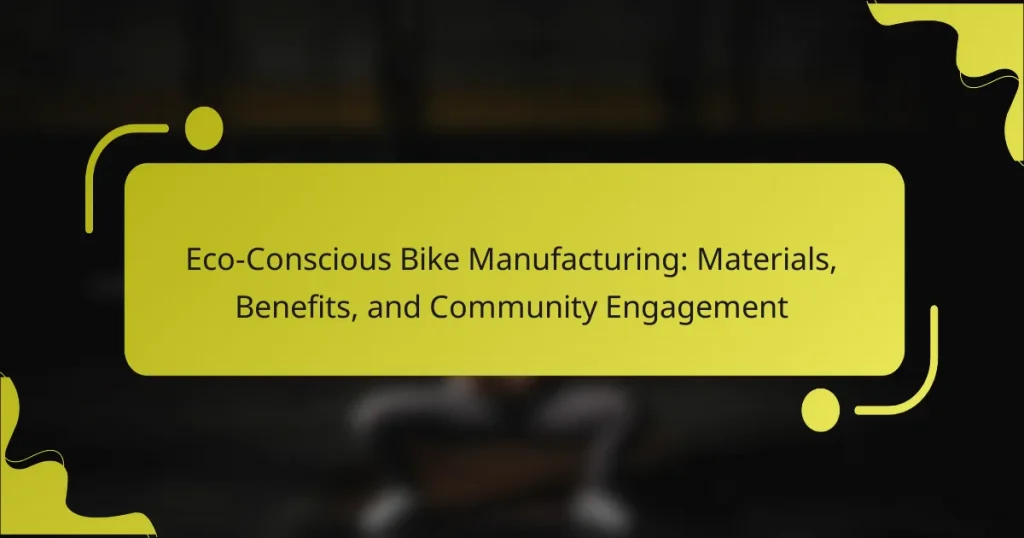Eco-conscious bike manufacturing significantly reduces environmental impact while promoting sustainable practices. This article explores materials like bamboo and recycled aluminium, the benefits of eco-friendly production, and the importance of community engagement. It also addresses challenges manufacturers face in adopting these practices and highlights leading brands committed to sustainability. Finally, effective promotion strategies for eco-conscious bikes will be discussed.

What are the key materials used in eco-conscious bike manufacturing?
Eco-conscious bike manufacturing primarily utilises materials such as bamboo, recycled aluminium, and hemp. Bamboo offers a lightweight and strong structure, while recycled aluminium reduces waste and energy consumption. Hemp provides a sustainable alternative for bike frames and components, promoting eco-friendliness. Additionally, biodegradable plastics and organic cotton are increasingly used in bike accessories, enhancing the overall sustainability of the product. These materials not only minimise environmental impact but also foster a community of eco-conscious consumers dedicated to sustainable practices.
How do sustainable materials compare to traditional options?
Sustainable materials generally outperform traditional options in environmental impact and lifecycle benefits. Eco-friendly materials, such as bamboo and recycled plastics, reduce carbon footprints and resource depletion. Traditional materials often rely on non-renewable resources and have higher emissions during production.
Sustainable materials can enhance brand image and attract eco-conscious consumers. For instance, brands using sustainable materials report increased customer loyalty. In contrast, traditional materials may face criticism for environmental harm.
The durability of sustainable materials can also rival or exceed that of traditional options. This longevity reduces the need for frequent replacements, contributing to overall sustainability. Traditional materials may require more frequent maintenance and replacement, leading to increased waste.
In summary, sustainable materials provide superior environmental benefits, strengthen brand loyalty, and offer comparable durability, making them a preferable choice for eco-conscious bike manufacturing.
Which innovative materials are emerging in the industry?
Innovative materials emerging in eco-conscious bike manufacturing include bio-based composites, recycled aluminium, and sustainable rubber. These materials enhance performance while minimising environmental impact. For example, bio-based composites reduce reliance on fossil fuels and offer lightweight options. Recycled aluminium provides durability and lowers energy consumption during production. Sustainable rubber, sourced from responsible plantations, ensures better tyre performance with reduced ecological footprint.
What role do recycled materials play in bike production?
Recycled materials significantly reduce environmental impact in bike production. They help conserve resources and lower carbon emissions. For example, using recycled aluminium and plastic can decrease energy consumption by up to 95%. This eco-conscious approach not only enhances sustainability but also appeals to environmentally aware consumers. By integrating recycled materials, manufacturers foster community engagement and promote a circular economy, encouraging responsible consumption and waste reduction.
How do regional preferences influence material choices?
Regional preferences significantly shape material choices in eco-conscious bike manufacturing. Local climates, cultural values, and available resources influence which sustainable materials are favoured. For example, areas with abundant bamboo may prioritise it for its rapid growth and low environmental impact. Additionally, communities that emphasise recycling may prefer materials like recycled aluminium or plastic. Understanding these preferences helps manufacturers align their production with local demands, enhancing community engagement and support.

What are the environmental benefits of eco-conscious bike manufacturing?
Eco-conscious bike manufacturing significantly reduces environmental impact. It utilises sustainable materials, minimises waste, and lowers carbon emissions. For instance, using recycled aluminium can decrease energy consumption by 95% compared to traditional methods. Additionally, eco-friendly practices promote community engagement through local sourcing and support for green initiatives. This holistic approach not only benefits the planet but also fosters a culture of sustainability.
How does reduced carbon footprint impact the cycling community?
Reduced carbon footprint positively impacts the cycling community by promoting sustainable practices and enhancing local engagement. Eco-conscious bike manufacturing uses materials like recycled aluminium and bamboo, reducing environmental harm. This shift fosters community initiatives, encouraging cyclists to advocate for greener transportation options. As a result, the cycling community grows stronger and more united in its commitment to sustainability.
What are the long-term sustainability benefits for manufacturers?
Long-term sustainability benefits for manufacturers include reduced costs, improved brand loyalty, and enhanced market competitiveness. Eco-conscious bike manufacturing fosters resource efficiency and minimises waste. This approach can lead to a 30% decrease in production costs over time. Additionally, engaging with communities strengthens customer relationships and promotes a positive brand image.
How does eco-conscious manufacturing affect consumer choices?
Eco-conscious manufacturing significantly influences consumer choices by promoting sustainability and ethical practices. Consumers increasingly prefer bikes made from recycled materials, which reduce environmental impact. This preference drives manufacturers to adopt eco-friendly processes, enhancing brand loyalty. Community engagement initiatives further strengthen consumer trust, as brands that support local causes resonate more with eco-conscious buyers.

How does community engagement enhance eco-conscious bike manufacturing?
Community engagement significantly enhances eco-conscious bike manufacturing by fostering collaboration and innovation. Engaging local communities allows manufacturers to source sustainable materials and gain insights into environmentally friendly practices. This collaboration can lead to the development of unique bike designs that reflect community values and preferences. Furthermore, community involvement can increase awareness and demand for eco-friendly products, ultimately driving growth in the sustainable bike market. By aligning manufacturing processes with community needs, companies can create a positive impact on both the environment and local economies.
What initiatives promote local involvement in bike production?
Local initiatives that promote involvement in bike production include community workshops, co-operatives, and educational programs. These initiatives foster collaboration, skill development, and sustainable practices. For example, local bike co-ops often engage residents in hands-on assembly and repair, enhancing community ties and promoting eco-conscious manufacturing. Such programs encourage the use of recycled materials, reducing environmental impact while empowering local artisans.
How do manufacturers collaborate with environmental organizations?
Manufacturers collaborate with environmental organizations to enhance sustainability in bike production. They engage in joint initiatives, share best practices, and develop eco-friendly materials. This collaboration leads to reduced carbon footprints and increased community awareness. For example, partnerships may focus on recycling programs or promoting sustainable transportation. Such efforts strengthen brand reputation and foster consumer loyalty.
What educational programs support sustainable cycling practices?
Educational programs that support sustainable cycling practices include initiatives focused on eco-conscious bike manufacturing, which emphasise the use of sustainable materials and community engagement. These programs often incorporate hands-on workshops, partnerships with local manufacturers, and awareness campaigns to promote environmentally friendly cycling. For instance, organizations may offer courses on the benefits of using recycled materials in bike production, highlighting their positive impact on reducing waste. Community engagement is crucial, as it fosters a culture of sustainability among cyclists and manufacturers alike.

Which challenges do manufacturers face in adopting eco-conscious practices?
Manufacturers face significant challenges in adopting eco-conscious practices, including cost implications, supply chain complexities, and regulatory compliance. High initial investment in sustainable materials can deter companies. Additionally, sourcing eco-friendly materials often involves navigating limited availability and inconsistent quality. Regulatory pressures may require manufacturers to meet stringent environmental standards, complicating the transition. Furthermore, consumer demand for sustainable products is increasing, pushing manufacturers to balance eco-consciousness with profitability.
How do cost considerations affect material selection?
Cost considerations significantly influence material selection in eco-conscious bike manufacturing. Manufacturers often prioritise sustainable materials that balance environmental impact and affordability. For instance, recycled aluminium and bamboo are popular choices due to their lower costs and reduced carbon footprint.
Additionally, the total lifecycle cost of materials, including durability and maintenance, affects long-term economic viability. Eco-friendly materials may have higher upfront costs but can lead to savings through longevity and reduced waste.
Community engagement also plays a role; manufacturers may choose locally sourced materials to support local economies, which can enhance brand loyalty and reduce transportation costs.
In summary, cost considerations drive the selection of materials that align with sustainability goals while ensuring economic feasibility.
What are the barriers to consumer acceptance of eco-friendly bikes?
Consumer acceptance of eco-friendly bikes faces several barriers, including higher costs, limited availability, and skepticism about performance. Many consumers perceive eco-friendly bikes as expensive compared to traditional options, which deters purchase. Additionally, the lack of widespread retail presence limits consumer access and awareness. Concerns about durability and functionality compared to conventional bikes also hinder acceptance.

What are the unique features of leading eco-conscious bike brands?
Leading eco-conscious bike brands feature sustainable materials, innovative designs, and community-driven initiatives. They prioritise recycled metals, bamboo, and biodegradable composites in their manufacturing processes. These brands often engage with local communities through programs promoting cycling as a sustainable transport option. Unique attributes include lifetime warranties and take-back programs for old bikes, enhancing their commitment to a circular economy. Additionally, many brands support environmental causes, contributing a portion of profits to conservation efforts.
How do specific brands differentiate themselves in sustainability?
Brands differentiate themselves in sustainability through innovative materials, unique production processes, and community initiatives. Eco-conscious bike manufacturers prioritise recycled materials and sustainable sourcing. For example, some brands utilise bamboo or recycled aluminium, reducing environmental impact. Additionally, they engage local communities through workshops and advocacy, fostering a culture of sustainability. This multifaceted approach not only enhances brand loyalty but also promotes eco-friendly practices within the cycling community.
What customer feedback influences brand innovation?
Customer feedback significantly influences brand innovation in eco-conscious bike manufacturing by highlighting consumer preferences for sustainable materials and practices. Engaging with customers allows brands to identify which eco-friendly materials resonate, such as recycled aluminium or bamboo. Additionally, feedback can reveal desired benefits, like durability and lightweight design. Community engagement initiatives, driven by customer input, foster loyalty and enhance brand reputation. This feedback loop ultimately drives innovation, ensuring products align with consumer values and environmental goals.

What are the best practices for promoting eco-conscious bikes?
Promoting eco-conscious bikes effectively involves focusing on sustainable materials, highlighting their benefits, and engaging the community. Use recycled materials like aluminium and bamboo to attract environmentally aware consumers. Showcase benefits such as reduced carbon footprint and improved health. Organise community events to raise awareness and foster a culture of sustainability. Collaborate with local organizations to amplify your message and reach a wider audience.
How can manufacturers effectively market eco-friendly features?
Manufacturers can effectively market eco-friendly bike features by emphasizing sustainability, community impact, and innovative materials. Highlighting the use of recycled materials can attract eco-conscious consumers. Engaging with local communities through events or partnerships enhances brand credibility. Showcasing environmental benefits, such as reduced carbon footprints, can resonate with target audiences. Additionally, transparent storytelling about the manufacturing process builds trust and loyalty.
What strategies can enhance community awareness and engagement?
To enhance community awareness and engagement in eco-conscious bike manufacturing, implement targeted strategies. Foster partnerships with local organizations, host community events, and utilise social media to share sustainable practices.
Encourage feedback through surveys and forums, allowing community input in product development. Highlight the environmental benefits of using eco-friendly materials, emphasizing their impact on reducing carbon footprints.
Promote educational workshops to inform the community about sustainable biking and its advantages. Create incentives for community members to participate in eco-friendly initiatives, reinforcing a sense of collective responsibility.
What common mistakes should manufacturers avoid in sustainable practices?
Manufacturers should avoid prioritising cost over sustainability, neglecting community input, and failing to assess the lifecycle of materials. These mistakes can undermine eco-conscious bike manufacturing. For example, using non-recyclable materials can lead to increased waste and environmental harm. Engaging with local communities fosters trust and encourages sustainable practices.




